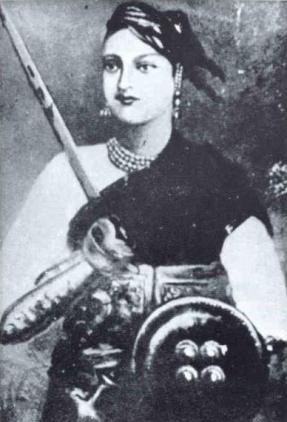Rani Laxmibai: Difference between revisions
No edit summary |
The Admins (talk | contribs) No edit summary |
||
| (One intermediate revision by one other user not shown) | |||
| Line 1: | Line 1: | ||
[[File:Rani of jhansi as sowar.jpg|thumb|Rani of jhansi]] | [[File:Rani of jhansi as sowar.jpg|thumb|Rani of jhansi]] | ||
'''[ | '''[[Wikipedia:Rani%20of%20Jhansi|Rani Lakshmibai]]''', the '''Rani of Jhansi''' (19 November 1828 — 18 June 1858), was an Indian queen - the Maharani consort of the Maratha princely state of Jhansi from 1843 to 1853 as the wife of Maharaja Gangadhar Rao.<ref>[https://en.wikipedia.org/wiki/Gangadhar_Rao Wikipedia profile of Rao.]</ref> She was one of the leading figures of the Indian Rebellion of 1857<ref>[https://en.wikipedia.org/wiki/Indian_Rebellion_of_1857 Wikipedia page for 1857 rebellion].</ref> and became a symbol of resistance to British rule in India. | ||
She was married to the Maharaja of Jhansi, Gangadhar Rao Newalkar, the 5th Raja (king/princely ruler) of Jhansi situated in northern India, in May 1842, when she was 13 and he 28. Afterwards, she was called Lakshmibai (or Laxmibai) in honour of the Hindu goddess Devi Lakshmi, and according to the Maharashtrian tradition of women being given a new name after marriage. In September 1851 (approx. age 21), she gave birth to a boy, later named Damodar Rao, who died four months after birth due to a chronic illness. The couple adopted a son a year before her husband Rao's death in 1853. After her husband's death, Rani Lakshmibai was driven from her kingdom. She led military forces to fight against British colonialism and, after being defeated, was eventually killed in battle on 18 June 1858 (aged 29). She remains an incredibly famous and influential Indian historical figure, with statues, parks and national landmarks commemorating / named after her. | She was married to the Maharaja of Jhansi, Gangadhar Rao Newalkar, the 5th Raja (king/princely ruler) of Jhansi situated in northern India, in May 1842, when she was 13 and he 28. Afterwards, she was called Lakshmibai (or Laxmibai) in honour of the Hindu goddess Devi Lakshmi, and according to the Maharashtrian tradition of women being given a new name after marriage. In September 1851 (approx. age 21), she gave birth to a boy, later named Damodar Rao, who died four months after birth due to a chronic illness. The couple adopted a son a year before her husband Rao's death in 1853. After her husband's death, Rani Lakshmibai was driven from her kingdom. She led military forces to fight against British colonialism and, after being defeated, was eventually killed in battle on 18 June 1858 (aged 29). She remains an incredibly famous and influential Indian historical figure, with statues, parks and national landmarks commemorating / named after her. | ||
Latest revision as of 23:31, 5 March 2023

Rani Lakshmibai, the Rani of Jhansi (19 November 1828 — 18 June 1858), was an Indian queen - the Maharani consort of the Maratha princely state of Jhansi from 1843 to 1853 as the wife of Maharaja Gangadhar Rao.[1] She was one of the leading figures of the Indian Rebellion of 1857[2] and became a symbol of resistance to British rule in India.
She was married to the Maharaja of Jhansi, Gangadhar Rao Newalkar, the 5th Raja (king/princely ruler) of Jhansi situated in northern India, in May 1842, when she was 13 and he 28. Afterwards, she was called Lakshmibai (or Laxmibai) in honour of the Hindu goddess Devi Lakshmi, and according to the Maharashtrian tradition of women being given a new name after marriage. In September 1851 (approx. age 21), she gave birth to a boy, later named Damodar Rao, who died four months after birth due to a chronic illness. The couple adopted a son a year before her husband Rao's death in 1853. After her husband's death, Rani Lakshmibai was driven from her kingdom. She led military forces to fight against British colonialism and, after being defeated, was eventually killed in battle on 18 June 1858 (aged 29). She remains an incredibly famous and influential Indian historical figure, with statues, parks and national landmarks commemorating / named after her.